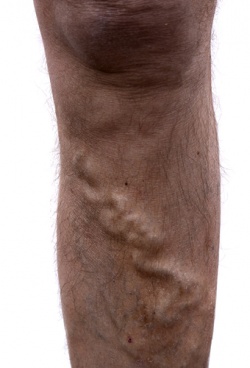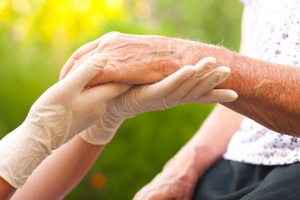Varicose Veins
Varicose veins are elongated, dilated, tortuous superficial veins whose valves are congenitally absent or scant or have become incompetent. Varicose veins typically occur in the legs. Varicose veins are a common problem affecting between 10% - 20% of the population, with increasing incidence with age, most common above 50 years. Varicose veins are 4 times higher in women than men.[1]
|
Varicose Veins | |
| Causes | Dietary Factors, Smoking, Posture, Infections, Prescription Medications |
|---|---|
| See Also | Cardiovascular Conditions, Obesity, Constipation, Hypertension |
| Books | Books on Cardiovascular Conditions |
| Articles | Articles on Cardiovascular Conditions |
Naturopathic Assessment
A thorough skin examination will be performed to determine the extent of varicosities.[2] The naturopathic assessment would include identifying any underlying conditions such as arterial insufficiency, neurological problems and musculoskeletal disorders that were associated with the varicose veins.[2].
Causal Factors
In order to stimulate the innate ability of the body to heal the causes of disease must be identified and addressed. With Varicose Veins, the causes are variable and include lifestyle and environmental factors. A detailed assessment is required to determine which factors are contributing to varicose veins.
Lifestyle
- Low levels of dietary fiber can contribute to varicose veins.[3]
- Food intolerances can aggravate varicose veins.
- Low levels of physical activity increase the occurence and risk of varicose veins.[4]
- Extreme physical activity, especially involving weight lifting, can contribute to the formation or worsening of varicose veins.
Social
External
- Cigarette smoking increases the risk of varicose veins.[4]
- Accidents and Injuries
- Lower limb injury predisposes one to varicose veins.[2]
- Clothing that is too constrictive or tight.[7]
Medical Interventions
- Prescription Medications
- Oral contraceptive use may lead to thrombosis in those with varicose veins.[8]
- Hormone replacement therapy is associated with increased risk of varicose veins.[2]
- Medical Treatments
- Varicose veins may develop post surgeryl.[2]
Physiology
Genetics
- There can be a genetic component to vein wall weakness.[5]
Diagnostic Testing
Related Symptoms and Conditions
Other conditions that are commonly associated with varicose veins include:[2]
- Obesity[5][4]
- Hypertension[6] Specifically high systolic pressure.[4]
- Pregnancy[10]
- Uterine fibroids
- Ovarian cysts
- Reticular and Spider veins.
- Phlebitis.
Characteristics
- Varicose veins occur because there is a degree of reversal of blood flow in the veins of the legs because of valve incompetency. This reversal causes dilation of the veins and loss of tissue tone.
- The abnormal swelling of veins in the legs is a symptom of a generally poor circulatory system with a loss of elasticity in the walls of the veins and particulary in their valves. When they are functioning normally, these valves prevent blood from flowing back away from the heart, but if their efficiency decreases some blood may stagnate in the vein, which then becomes swollen and twisted, causing aching and abnormal fatigue of the legs.
- Hormonal changes may play a role as well as blood volume changes.[5]
Common signs and symptoms include:[2]
Naturopathic Treatment
The goal of naturopathic treatment is to support and work in tandem with the healing power of the body and to address the causal factors of disease with individual treatment strategies. Varicose veins are considered a chronic disease. The aim of treatment is to strengthen venous and capillary walls, decrease vascular damage and reduce oxidative stress. Referral for surgical consideration is reasonable for the patient with symptoms that persist after conservative efforts have failed.[2]
It is always advisable to work with a naturopathic doctor before engaging in any treatment plan.
Home Care
Home Care strategies include:[2]
- Use of graduated compression stockings.
- Periodic elevation of the legs throughout the day can alleviate the discomfort associated with varicose veins and can assist circulation.
Lifestyle
Lifestyle recommendations include:
- Dietary recommendations include:
- Consume a diet that focuses on whole unprocessed food (whole grains, legumes, vegetables, nuts and seeds).[11]
- Water. Ensure you drink adequate water.
Naturopathic Therapies
The prescribing of naturopathic therapies requires the guidance of a naturopathic doctor as it depends on a number of factors including the causal factors, a person's age, prescription medications, other conditions and symptoms and overall health. It is always advisable to work with a naturopathic doctor prior to taking any natural therapies.
Naturopathic Therapies for Varicose Veins include:
- Clinical Nutritional Supplementation includes
- Vitamins such as Vitamin C[3],Vitamin E.[3]
- Minerals such as Zinc.[3]
- Other supplements such as Flaxseed oil, PCO extracts, aorta glycosaminoglycans.[11], bioflavonoids[3], bromelain.[3], Grape Seed Extract
- Botanical remedies[12], [13],[3] such as Bilberry (Vaccinum myrtillus), Butcher's broom (Ruscus aculeatus), Calendula (Calendula officinalis), Horse Chestnut (Aesculus hippocastanum), Ginkgo (Ginkgo biloba), Gotu kola (Centella asiatica'), Grape seed (Vitis vinifera), Pine bark (Pinus maritima), St. John's Wort (Hypericum perforatum), Witch Hazel (Hamamelis virginiana)[14]
- Homeopathic remedies[15], [16] such as Aesculus, Bellis[17],Calcarea fluorica,Carbo veg[17], Hamamelis[17],Hydrofluoricum acidum,[17]Lachesis, Millefolium, Pulsatilla, Vipra berus[17], Zincum metallicum.[17]
- Differentials to consider include; mild blood stagnation, qi and blood stagnation, blood stagnation and qi deficiency.[18].
- If edema is part of the case include differentials such as; wind cold, spleen deficiency with congested fluids, pregnancy, menopause, heart and kidney yang deficiency, kidney yang deficiency, spleen deficiency, heart yang deficiency.[18]
- Hydrotherapy such as; Constitutional hydrotherapy.[19]
References
Reviewed by Iva Lloyd, BScH, RPE, ND [1]
- ↑ 1.0 1.1 Hoffmann David (1992) Therapeutic herbalism: A correspondence course in phytotherapy
- ↑ 2.0 2.1 2.2 2.3 2.4 2.5 2.6 2.7 2.8 2.9 Goroll A, Mulley A, editors.(2009) Primary Care Medicine – Office evaluation and management of the adult patient. Boston: Lippincott Williams and Wilkins;163:pg314-323
- ↑ 3.0 3.1 3.2 3.3 3.4 3.5 3.6 3.7 Murray Michael, Pizzorno Joseph (1998) Encyclopedia of Natural Medicine. 2nd ed. Three Rivers Press, New York:pg826-830
- ↑ 4.0 4.1 4.2 4.3 Tüchsen F, Krause N, Hannerz H, Burr H, Kristensen TS(2000)Standing at work and varicose veins.Scand J Work Environ Health.;26(5):414-20. PMID:11103840
- ↑ 5.0 5.1 5.2 5.3 Fowkes FG, Lee AJ, Evans CJ, Allan PL, Bradbury AW, Ruckley CV(2001)Lifestyle risk factors for lower limb venous reflux in the general population: Edinburgh Vein Study.Int J Epidemiol.;30(4):846-52. PMID:11511615
- ↑ 6.0 6.1 6.2 Metcalfe C, Davey Smith G, Macleod J, Heslop P, Hart C (2003) Self-reported stress and subsequent hospital admissions as a result of hypertension, varicose veins and haemorrhoids. J Public Health Med.;25(1):62-8. PMID:12669921
- ↑ Carpentier P, Priollet P.(1994)Epidemiology of chronic venous insufficiency.Presse Med.;23(5):197-201.PMID:8177867
- ↑ Clifford, R (1978) Oral contraceptives, venous thrombosis, and varicose veins. Royal College of General Practitioners' Oral Contraception Study. J R Coll Gen Pract.;28(192):393-9. PMID:702453
- ↑ Mironiuc A, Palcău L, Rogojan L, Micula S, Gherman C (2011)Is there a correlation between the CEAP score and the histopathological findings in varicose disease?Rom J Morphol Embryol.;52(1):117-21. PMID:21424042
- ↑ Tisi P (2007)Varicose Veins. BMJ Clin Evid (online)[cited April 2012]:pg1-12. PMID:19450366
- ↑ 11.0 11.1 11.2 Murray Michael (1996) Encyclopedia of Nutritional Supplements, The Essential Guide for Improving Your Health Naturally Prima Publishing
- ↑ Godfrey Anthony, Saunders Paul Richard, Barlow Kerry, Gilbert Cyndi, Gowan Matthew, Smith Fraser (2010) Principles and Practices of Naturopathic Botanical Medicine, Vol 1: Botanical Medicine Monographs, CCNM Press, Toronto
- ↑ Boon Heather, Smith Michael (2004) The Complete Natural Medicine Guide to the 50 Most Common Medicinal Herbs, Robert Rose, Toronto
- ↑ Zeylstra H (1999) Hamamelis virginiana British Journal of Phytotherapy;5(1):23-28.
- ↑ Hershoff Asa (2000) Homeopathic Remedies, A Quick and Easy Guide to Common Disorders and their Homeopathic Treatments, Avery Publishing Group, New York
- ↑ Ullman Robert, Reichenberg-Ullman Judyth (1997) Homeopathic Self-Care, the quick and easy guide for the whole family. Prima Publishing
- ↑ 17.0 17.1 17.2 17.3 17.4 17.5 Rose Barry, Scott-Moncrieff Christina(1999) Homeopathy for Women. Firefly Books Ltd.:pg81
- ↑ 18.0 18.1 Kuoch David(2011) Acupuncture Desk Reference. 2nd ed. Acumedwest Inc.:pg290-307
- ↑ Boyle W, Saine A (1988). Lectures in Naturopathic Hydrotherapy. Eclectic Medical Publications.:pg144


